
Monty Don welcomes us to Episode 4 of Gardeners' World 2021 and Nell is laying in the sun watching Monty hard at work in the Paradise Garden which he started a few years ago.
Presenters

Monty is in the Paradise garden and he is telling us that he had uses a Grass as a Matrix plant, which is one that is used in all 4 beds.
The grass was Stipa Tenuissima and the idea was that the flowers would appear through it but this did not go to plan.

The grass needs poor soil with good drainage and even after adding grit to the soil most of the plants have died.
So Monty digging them up to go to the compost heap, he not too bothered as he grew them using just the 1 packet of seed.
He is going to use another plant that he can get for free out of the garden.
Oriental Poppies were a feature in the Jewel garden during May and June for many years but they stopped performing well and last year there were none appear at all.
Monty thought it was just a problem with the gardener but it turns out other growers have also had problems.
Downy Mildew is a fungus that attacks the Poppy and has worsen due to wet summers.

He is not giving up and is planting a variety called Beauty of Livermere and the most famous one.
He is going to give them a fighting change by putting them at the edge of the border where the Box hedges were.
As well as the good ventilation they are going to get he adds some grit to the planting hole which will help with drainage which means as long as you have that the soil type does not matter.

The poppy will fill the corner and will add one to the other bed for symmetry and then waters them in until established.
They take a few years to get to a good size and hopefully with not get the Downy Mildew.
At Longmeadow Monty has cut lawn mowing down to a minimum and they have long grass with paths mown through them instead.

The long grass borders has bulbs or wild flowers growing in them amongst the grass.
If you do prefer a traditional lawn try to have 1 area of long grass as it is great for the wildlife.
Now the time to sow Nasturtiums which Monty at his potting bench thinks are undervalued.

He says they come in such a variety of rich colours and he has 3 varieties he has chosen for underplanting in the Jewel garden.
The first one is Black Velvet which is a deep burgundy, a bright red called Empress of India and finally an orange called Tip Top Alaska Deep Orange.
The secret to growing them is to use poor soil, the sweeping off the potting shed floor, if the soil is rich you get lots of foliage and hardly any flowers.



He is using his seed compost and putting them in plugs as they are large seeds.
Nasturtium flowers also make an attractive and tasty addition to salads.
These are a good plant to get children to grow as the seeds are big, easy to grow and you can eat them.
He will water them and put them on a warm windowsill or greenhouse they do not need a heated mat to germinate.
Monty in the writing garden planting a white Umbellifer called Orlaya Grandiflora which he as grown from seed which he had sown in September.

This will flower in late Spring to Summer but the garden is already full of white flowers from the Summer Snowflake Leucojum and Daffodil Thalia.
There is also some very early tulips appearing.
The Potatoes Monty chitted are now ready to plant out and the shoots are knobbly and short, all ready to start growing.
This gives the potatoes like First Earlies a good start and you then also miss the blight.

Monty says he finds his raised beds ideal for Potatoes just make a deep hole and pop them in and in a bed his size he would plant 3 width ways.
He plants them with the strongest chit upwards and if you plant them deep that should protect them from frost.
By planting them close together you will only get small potatoes and to get the maximum crop they need to be about 3 foot apart.
With new potatoes it is the taste that matters.
Monty cannot earth them up in the raised beds so they will be mulched instead to protect them from frost damage.
The mulch could be compost, straw or soil to protect the leaves as they come up.
A simple flower like the Wood Anemone, Anemone Nemorosa is giving Monty lots of pleasure in his garden and this simple flower was planted 20 years ago, just a few but they have spread everywhere and the flowers open in the morning and close at night.

They are quite slow at spreading so you can tell if a woodland has been there for some time and they like to grow at the edge as they like some sunlight.
In last weeks programme Monty cut back his Dryopteris Filix-Mas Ferns and now he is going to divide them

The plant has 5 knuckles so could make 5 plants but he is just cutting them in half and because they were too close to the path he can move them back and getting twice as many Ferns.
He has never divided one this big so he has dug it up and Monty is down to his shirtsleeves for the first time this year.
Ferns will grow in most soils with Dryopteris being the most adaptable and will grow anywhere.
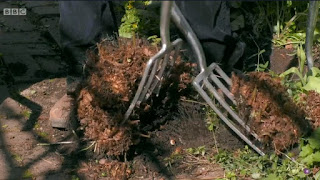
He places it on the path and using 2 forks he tries to tease them apart, that didn't work so out comes the knife to cut through them.
It is really tough and woody so knife first then use the forks but finally they are apart.
He is planting some at the back of the pond and also in the Copse.
Monty replants one half further back from the path.
The Stipa Tenuissima was the wrong grass for the Paradise Garden but Monty has the right one Pheasant Grass which used to be known as Stipa Arundinacea.
It is now known as Anemanthele Lessoniana but Pheasant Grass is less of a mouthful.
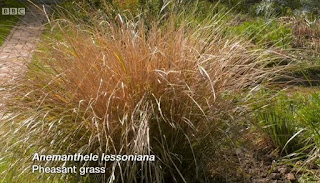
It also has great foliage but it is also more adaptable to our climate and growing conditions and dies back after 3-4 years but it does then seed itself.
He is digging them up from the grass borders so will have about 20 plants to add to the Paradise Garden.

Advolly says lawns are an integral part of our gardens and feel like they have been forever.
Lawns have not always been so pristine and once they were a bumpy invention full of camels and for decades the lawn could only be afforded by the very wealthy!
The word lawn was first mentioned in the 1500s a described an open space in a forest or a glade.
It was not until the 1700s that big lawns became the thing to have when garden landscaping was all the rage for the big houses.
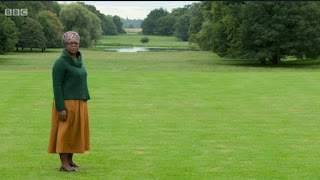
Designers like Capability Brown took on the redesigning of entire estates creating huge green spaces of grass with carefully placed groups of trees, man made lakes with bridges across.
Advolly is at Cottesbrooke Hall in Northampton were long sweeping lawns right up to the house door.
This did not come without issues as the best way to keep the grass nice and short was by having sheep graze the lawns but these needed to be kept out of the houses.

A ha-ha was added which is a deep ditch which got its unusual name by the fact it was made to be invisible from the house and when people would then discover them they would go 'ha-ha', apparently.
The grass nearer the house was cut by Sidesmen and they would start cutting at Dawn as the dew made it cut better and they had to stop to sharpen their scythes several times in just 1 hour.
This was hard work and women were also employed to pick up the cut grass behind them and collecting it in baskets.

The longer grass was made into hay but as you got to the shortest grass nearest the house, the front lawn, only the best Sidesmen were used to cut just millimetres off the neat lawn.
Women would then sweep up the tiny blades of cut grass with brooms and put in the their baskets.
For the demonstration they are using a modern Austrian Scythe which is easier to use and Advolly says it mesmerising to watch him at work.
In the 1820s a man called Edwin Beard Budding who worked building machines for the woollen trade had an idea for the first lawn mowing machine based on a shearing machine that uses rollers to cut off the thread.

They have a replica of the first ever lawnmower that Budding designed which was operated by 2 people, 1 pulling at the front and the other guiding it from the back.
Apparently Budding tested the machine at his home at night to keep it a secret but because of the noisy machine the neighbours complained.
The machine was patented in 1830 and lawn envy started, the smarter, shorter and flatter your lawn was the higher your standards.
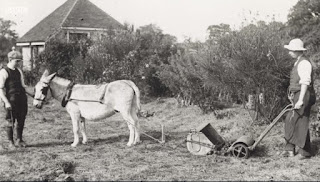
Ponies or Donkeys replaced the person pulling the mower and they wore boots so they didn't damage the lawn.
These were especially made to measure by drawing round there hooves and they even appeared at Wimbledon rolling the tennis lawns.

At London Zoo a camel was used instead and left no hoof prints.
The Victorians then invented all sorts of small mowers for smaller and more difficult areas.
Wealthy Victorians like the ones that lived at Brodsworth Hall near Doncaster could then have lots of small island beds in the lawn to show off their exotic plants.

The lawn mowers were made to cope with any size and shape of flower bed.
Advolly is trying out an 1880s lawn edger which she is enjoying.
Some Victorians thought the style of these flower beds and lawns were too garish but more machines were made including the first sprinkle system thats still working today.
The final stage for lawns was some time away and that was to arrive in small urban gardens (and I been moaning about cutting them once a week ever since! Pete Free 🌻)

We are returning to see a visit Adam made to Choumert Square in South London whose tiny front gardens form one amazing display.
Adam says this is a gem hidden in the heart of Peckham where every garden is full of character and variety.
It is a real community all with gardening in common and he speaks to resident Sally Cowling and she tells him the gardens started in 1984 when a resident a civil engineer and his wife laid the main pathway and she started with the greenery.
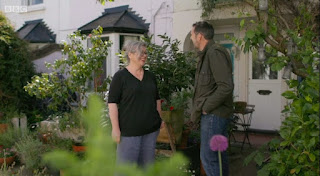
The biggest front garden is 3m x 2m and the smallest is 1m x 3m and these are the middle houses.
In Sally's small space she has Clematis Montana climbing up to her balcony and Adam says its not usually a plant for small spaces.
Each garden is individual, some architectural, some woodland and most of the gardens spill out on to the paths.
He sits in a garden that feels coastal, there big sleepers as raised beds and a bench with a rose over it that smells divine.
There also herbs amongst Wall flowers which look after themselves.
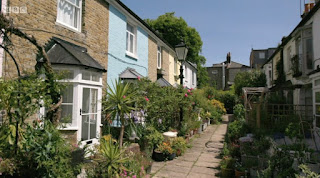
The gardens also make a great wildlife corridor.
In one garden there an Oak tree thats about 20 years old in a pot next to it a Cotinus which usually grow huge but its in a pit and can be cut back hard and if it gets pot bound just pot it on.
It also has a mix of textures with a fern growing next to Viola and the use of foliage gives you all year round interest.

Adam always like to have water in the garden and in this small space they have a large deep pot complete with goldfish and an yellow iris and on the opposite wall is a fountain giving the sound of trickling water.
Adam says it proves you do not need a big space to have a garden, these all have charm and personality.
Katrina Harrison
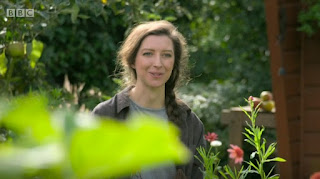
Katrina has an allotment in one of the oldest and most beautiful sites in St Ann's Allotments in Nottingham.
Stepping into her allotment Katrina says she in her own little garden world, all worries and troubles disappear and its just her and the wildlife and the garden.
Growing up in a small town she had a childhood spent outdoors and then as an adult moved to a city centre flat in Nottingham and she felt Claustrophobic and cooped up and missing the outdoors.
She then decided to sign up for an allotment which is the oldest and largest in Western Europe and its right in the centre of the city.

It is like a secret garden with all the plots divided by hedgerows over 34 miles of it and each plot has its own gate and entrance making them very private.
Katrina says her generation are interested in allotments and gardening as they do not have their own gardens.
Nothing tastes so good as eating your first homegrown strawberry of the summer.
She had no previous experience and learnt as she went along and transformed her plot and she caught the gardening bug.

Growing her own and connecting with the soil made her think what she wanted from life and she was working in a busy fast paced job so she started to think of going into Horticulture as a career.
Katrina shared her progress on line with lots of photos and a Head Gardener of a private estate contacted her about applying for a job there.
She got her dream job and has completely changed careers.
To prevent wireworm she grows her potatoes in large pots and she is harvesting a pot to see what they are like.

There is plenty of decent sized buried treasure and she is very excited to see her rewards.
For her Squash she is trying something new for her and growing them successfully vertically as they have not got any mildew.
Her allotment was a blank canvas but she did not design it but has played with her creativity using colour and shapes and she loves to upcycle in the plot.

After breaking her Chimenea a friend gave her she has turned it into a planter, she uses a lantern as a bird feeder.
Around her apple tree she has stepping stones for a bit of fun and she picked them up second hand.
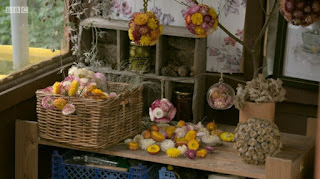
Katrina grows Straw Flowers for drying and making decorations and she likes to do craft in the Winter when there not so much to do at the allotment.
Gets your hands in the earth and sowing seeds makes you start thinking about things to come and gives you hope for the harvesting and sharing of your produce.
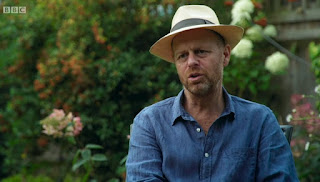
We are revisiting Joe visit to Presenter and journalist Kate Garraway who has had her life changed by Covid when her husband Derek contracted Covid in March 2020.
On Joe first visit to Kate's garden, Derek had been in hospital for 6 months and the garden had become a sanctuary for Kate and the children.
Joe is impressed with the size of their garden for London and they bought the house 4 years ago for the garden.
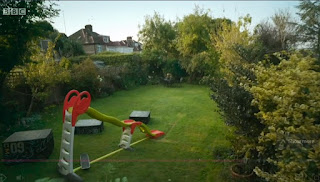
The garden was covered in brambles, weeds and Flag Iris but it also had some mature Apple, Greengage and Plum trees.
The first year they just cleared it and waited to see what grew and Joe said you did exactly what you are supposed to do with a new garden.
Roses grew everywhere like a scene from Sleeping Beauty and it looked so beautiful.

Kate talks about the 'odd' year they and the world has had and Joe says 'your world been turned upside down.
Derek didn't have a cough or a temperature he just said at the end of March 2020 he felt unwell and they spoke to Doctors and finally one said 'call an ambulance'.
At the hospital he tested positive for Covid then everything sped up and took hold and swept through his body affecting it all.

This left him fighting to even breathe and they called her they were putting him in an induced coma as he not woken up.
Derek had been talking previously about a lockdown so they went to a garden centre and their daughter Darcey who 14 and Billy aged 10 after suggesting they grow their own vegetables in case of shortages.
It gave Darcey something positive to do when she was feeling helpless and they nurtured the produce.

The vegetable plot became their saviour when difficult questions like how are you feeling about our Dad and the fact he could die and its too big a thing to discuss but once they were together planting they started sharing and talking.
'It's an activity, and it's an activity about life'.
What was sad was Derek was not there to eat his favourite Radishes when they were ready, so they started planting things that took longer to grow, hoping he be better by then.

Then it was bulbs they started thinking about planting them so the garden will be full of colour for Derek.
The Hospital would ring saying that he was very poorly and may not make it through the night so she would go out in the garden and water plants, she was trying to keep the hope alive he would pull through.
She was rewarded by beautiful yellow flowers on the Flag Iris Derek loves and last year Kate added some Allium bulbs amongst them.

They looked lovely after the Iris flowers had died away and even have attractive seed heads after.
The garden has been so important for Kate and her family ringing her hope, joy and let go in.
'You can't think short-term in a garden. You have to plan. You have to have hope. You have to invest in a future.'
Kate gives us an update and shows off the bulbs they planted and the Daffodils are doing well particularly round the tree. She also got some in a pot with her Camellia.
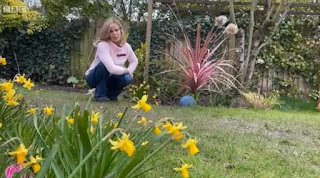
They have burst through with hope and now they have Summer bulbs and seeds to plant and are planning the next stage.
Her son Bill is doing a cracking job acting as camera man.
Viewers Videos
Laura and Dog Riley from Poole in Dorset

Laura has foxes living in the garden and badgers and loads of birds visit the garden so it is a very wildlife friendly garden.
Today she wants to talk to us about slow worms which are a legless lizard and are so beneficial for us gardeners.
They eat the slugs and snails in the garden protecting the lettuces.

You can encourage them into your garden by having compost bins and heaps and as slow worms are reptiles they need heat from the environment as they cant make their own, so warm compost is a perfect place for them.
They do like to live in long grass so you need to be careful when cutting the lawn and best to look out for slow worms as well as hedgehogs.
Kendra from Maine USA

Kendra cannot get out in the garden yet but has a growing room where she been spending a lot of time.
It is new this year and she has added lots of shelving and 8 LED lights and it is in the basement.

Once the seeds have germinated she places the seedlings into a seed starting mix she will then harden them off before going in a raised bed or the ground.
With the garden being inaccessible having this space means she can garden all year round and has been good for her mental wellbeing as well as for enjoying what she has grown.
Pamela Wardell from Milton Keynes

Pamela loves flowers and she loves them all whatever size, shape or colour.
She often needs to stake them using bamboo canes so she has made a storage area out of old chimney pots.
She bought them on line and has stones under to raise them off the ground so any rain water can drain out without damaging the canes.

The chimney pots are ideal and Pamela thinks they look better than just having a small plant in the top of them.
Ideal and she loves them!

Nell is watching Monty work in the Paradise Garden and then moves on to the Jewel Garden.

First sighting of Patti asleep in the Jewel Garden.

Patti watching Monty by the potting shed then Nell joins her so she wanders off.
Nell asleep whilst potatoes are planted.

Patti in the woodland looks like Monty got her caged.
Nell & Patti are watching Monty divide Ferns.

Sow Peas
As the soil warms up its time to sow your peas straight into the soil in a wide drill 2 inches apart in parallel rows.
Pot up bedding Plugs
These are now appearing in Garden Centres and bought as plugs you can grow on until the time is ready to plant out after the last frost.
Plant Gladioli
These make lovely border plants and also for cut flowers.
Run a deep drill and line the bottom with grit for drainage and plant the corms 9 inches apart and cover them over.

All photographs are copyright of BBC.com

No comments:
Post a Comment